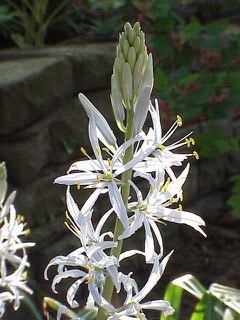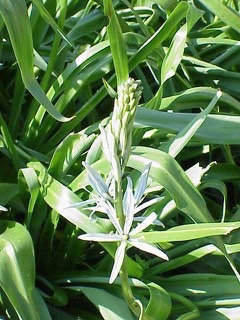 |
|
Kurt Stüber wikimedia.org |
 |
| Kurt Stüber wikimedia.org |
Translate this page:
Summary
Physical Characteristics

 Camassia cusickii is a BULB growing to 0.9 m (3ft) by 0.6 m (2ft in) at a medium rate.
Camassia cusickii is a BULB growing to 0.9 m (3ft) by 0.6 m (2ft in) at a medium rate.
See above for USDA hardiness. It is hardy to UK zone 3.
Suitable for: light (sandy) and medium (loamy) soils and prefers well-drained soil. Suitable pH: mildly acid, neutral and basic (mildly alkaline) soils. It can grow in semi-shade (light woodland) or no shade. It prefers moist soil.
UK Hardiness Map
US Hardiness Map
Synonyms
Quamasia cusickii (S.Watson) Coville
Plant Habitats
Edible Uses
Edible Parts: Root
Edible Uses:
Bulb. The cooked bulb has a sweet, anise-squash flavour. Pressure cook at 250°F or 120°C for nine hours. A larger bulb than other species in this genus but the flavour is considered poorer [1-2]. Considered pungent, slimy, and bitter tasting by some (summitpost.org). The bitter taste is due to saponins in the plant. Commonly confused with C. quamash where Native Americans would harvest the roots to eat raw as a vegetables, or boiled them to create a sweet, molasses-like treat.
References More on Edible Uses
Medicinal Uses
Plants For A Future can not take any responsibility for any adverse effects from the use of plants. Always seek advice from a professional before using a plant medicinally.
None Known
References More on Medicinal Uses
The Bookshop: Edible Plant Books
Our Latest books on Perennial Plants For Food Forests and Permaculture Gardens in paperback or digital formats.

Edible Tropical Plants
Food Forest Plants for Hotter Conditions: 250+ Plants For Tropical Food Forests & Permaculture Gardens.
More

Edible Temperate Plants
Plants for Your Food Forest: 500 Plants for Temperate Food Forests & Permaculture Gardens.
More

More Books
PFAF have eight books available in paperback and digital formats. Browse the shop for more information.
Shop Now
Other Uses
Uses include food forests, informal gardens, cottage gardens, prairie and meadows. Locations include: garden banks and slopes, beds and borders and can be underplanted with roses and other shrubs. Showy, cut flowers. Thrives among perennials. C. cusickii can naturalize and serve as a good ground cover.
Special Uses
Food Forest Ground Cover
References More on Other Uses
Cultivation details
Hardy Perennial Bulb found in temperate to subtropical locations. Prefers moist, fertile soil in full sun to partial sunlight. Soil chalk, loam or sand which is acid, alkaline or neutral. It tolerates clay and dry soil. Soil moisture moist but well-drained. Unlike most bulbs, it prefers soil that has a bit more moisture but is intolerant of waterlogging. Deer- and rodent-resistant. Flowers spring to early summer. The plant is heat tolerant in zones 12 through 1. (Plant Hardiness Zones show how well plants withstand cold winter temperatures. Plant Heat Zones show when plants would start suffering from the heat. The Plant Heat Zone map is based on the number of "heat days" experienced in a given area where the temperature climbs to over 86 degrees F (30°C). At this temperature, many plants begin to suffer physiological damage. Heat Zones range from 1 (no heat days) to 12 (210 or more heat days). For example Heat Zone. 11-1 indicates that the plant is heat tolerant in zones 11 through 1). For polyculture design as well as the above-ground architecture (form - tree, shrub etc. and size shown above) information on the habit and root pattern is also useful and given here if available. The plant growth habit is a clumper with limited spread [1-2]. The root pattern is a bulb.
References Carbon Farming Information and Carbon Sequestration Information
Temperature Converter
Type a value in the Celsius field to convert the value to Fahrenheit:
Fahrenheit:
The PFAF Bookshop
Plants For A Future have a number of books available in paperback and digital form. Book titles include Edible Plants, Edible Perennials, Edible Trees,Edible Shrubs, Woodland Gardening, and Temperate Food Forest Plants. Our new book is Food Forest Plants For Hotter Conditions (Tropical and Sub-Tropical).
Shop Now
Plant Propagation
Propagated by removing the offsets that have formed round the main bulbs. Plant 6 inches (150 mm) deep in late summer or early fall. In very cold areas, the soil should be mulched to protect the bulbs in late autumn.
Other Names
If available other names are mentioned here
Cussick's camas, Wild hyacinth
Native Range
NORTHERN AMERICA: United States, Idaho (w.-c.), Oregon (northeast),
Weed Potential
Right plant wrong place. We are currently updating this section.
Please note that a plant may be invasive in one area but may not in your area so it's worth checking.
None Known
Conservation Status
IUCN Red List of Threatened Plants Status :

Growth: S = slow M = medium F = fast. Soil: L = light (sandy) M = medium H = heavy (clay). pH: A = acid N = neutral B = basic (alkaline). Shade: F = full shade S = semi-shade N = no shade. Moisture: D = dry M = Moist We = wet Wa = water.
Now available:
Food Forest Plants for Mediterranean Conditions
350+ Perennial Plants For Mediterranean and Drier Food Forests and Permaculture Gardens.
[Paperback and eBook]
This is the third in Plants For A Future's series of plant guides for food forests tailored to
specific climate zones. Following volumes on temperate and tropical ecosystems, this book focuses
on species suited to Mediterranean conditions—regions with hot, dry summers and cool, wet winters,
often facing the added challenge of climate change.
Read More
Expert comment
Author
S.Watson
Botanical References
Links / References
For a list of references used on this page please go here
Readers comment
| Add a comment |
|
If you have important information about this plant that may help other users please add a comment or link below. Only comments or links that are felt to be directly relevant to a plant will be included. If you think a comment/link or information contained on this page is inaccurate or misleading we would welcome your feedback at [email protected]. If you have questions about a plant please use the Forum on this website as we do not have the resources to answer questions ourselves.
* Please note: the comments by website users are not necessarily those held by PFAF and may give misleading or inaccurate information.
To leave a comment please Register or login here All comments need to be approved so will not appear immediately.
|
Subject : Camassia cusickii
|
|
|
|